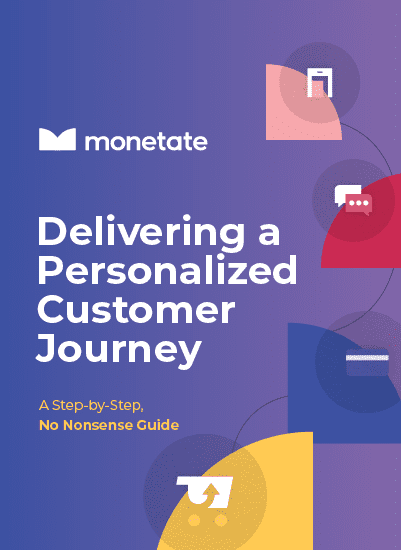A step-by-step, no nonsense guide
Delivering a Personalized Customer Journey
Personalization has become a major part of every serious eCommerce brand’s strategy. Knowing who your customers are, where they are, what they want, and how best to give it to them is something that all online retailers need to do.
In the competitive realm of eCommerce, offering a Personalized Customer Journey is imperative for securing customer loyalty and standing out in the marketplace. Personalization involves understanding the unique needs and preferences of customers, including who they are, where they are located, what they desire, and how they prefer to engage with online retail spaces.
Implementing a thoughtful personalization strategy allows brands to provide tailored products, services, and content, enhancing the shopping experience and fostering long-term customer relationships. As consumers increasingly expect customized interactions, delivering a Personalized Customer Journey has transitioned from being a luxury to a necessity for serious eCommerce brands.
What is Personalized Customer Experience?
Personalized Customer Experience refers to the practice of creating and delivering individualized interactions, services, or product recommendations to customers based on their unique preferences, behaviors, and historical interactions with the brand. This approach aims to enhance the customer’s experience by making it more relevant, enjoyable, and convenient, ultimately fostering loyalty and increasing customer retention.
In the realm of eCommerce, a personalized customer experience may involve displaying personalized content, product recommendations, and offers to different visitors. For instance, a first-time visitor might see popular or trending items, while a returning customer could see suggestions based on their previous searches and purchases. This level of customization creates a more engaging and satisfying shopping experience, encouraging customers to complete their purchases and return to the platform in the future.
Overcoming Challenges in Delivering Personalized Customer Experiences
Many digital and marketing leaders are trying to develop their personalization in a way that caters to the individual site visitor across the customer journey. But their progress is hampered by an overwhelming amount of advice, gimmicks, buzzwords, and excited talk about full-journey personalization.
This can be frustrating when looking for serious solutions to the real problems brands face. Attempting to craft individual experiences at a scale that caters to thousands, or even hundreds of thousands of customers and site visitors is no easy task.
Every online brand is different, and so the personalization challenges they face are unique. But there are some common factors that hamper eCommerce businesses in their attempts to deliver personalized experiences across the customer journey:
- A lack of an integrated approach
- An inability to scale solutions
- Use of multiple, disparate personalization tools
- Siloed data
- Lack of access to data for non-technical teams
- Misaligned goals across your business
How to Identify Your Most Important Customer Types
In the diverse landscape of eCommerce, recognizing and prioritizing your most valuable customer groups is crucial for effective personalization and business growth. Different customer segments contribute differently to your business, and identifying these key segments can significantly enhance your personalization strategy.
Understanding Customer Segmentation
Customer segmentation involves dividing your customer base into distinct groups that share common characteristics. This segmentation enables more targeted and meaningful interactions. Key criteria for segmenting customers include:
- Demographics and Psychographics: Grouping customers based on age, gender, income, lifestyle, and interests.
- Purchase History and Behavior: Segments based on past purchases, browsing patterns, and engagement with your brand.
- Customer Value: Identifying high-value customers who contribute significantly to your revenue.
- Geographical Location: Tailoring experiences based on where your customers are located.
By utilizing advanced analytics and customer data, you can create segments that are finely tuned to the nuances of your customer base.
Applying the PIE Framework for Prioritization
To effectively prioritize these segments, consider adopting the PIE framework:
- Potential: Evaluate the potential impact of personalization on each segment. Consider factors like the likelihood of increased engagement and potential revenue growth.
- Importance: Assess the size and revenue contribution of each segment. Larger segments or those with high spending power should often be prioritized.
- Ease: Determine how straightforward it is to identify and target each segment. The easier it is to recognize and reach a segment, the more feasible it is to personalize their experience effectively.
Start by focusing on segments with high potential and importance. As you refine your strategy, you can expand to include other segments, balancing the ease of identification with the potential benefits.
Seamlessly Integrating Segmentation into Personalization Strategies
Integrating these identified segments into your personalization strategy is key. Tailoring content, offers, and experiences to each segment enhances the relevance and effectiveness of your interactions. By doing so, you not only meet the unique needs of each customer group but also set the stage for increased loyalty, engagement, and revenue.
With a clear understanding of your most important customer types, you’re well-equipped to deliver personalized experiences that resonate. This approach is a cornerstone in crafting tailored customer journeys, as explored in the following section.

Benefits of Personalized Customer Journeys
Crafting Personalized Customer Journeys brings forth a myriad of benefits that not only elevate the customer experience but also significantly contribute to your eCommerce brand’s bottom line.
- Increased Customer Loyalty: Personalization fosters a deeper connection between brands and consumers. When customers feel understood and valued through tailored interactions and offers, they are more likely to develop loyalty to your brand, becoming repeat buyers and brand advocates.
- Enhanced Customer Lifetime Value (CLV): Loyalty leads to increased customer retention, thereby boosting the Customer Lifetime Value (CLV). Personalized journeys ensure that customers consistently have memorable and satisfying experiences, prompting them to engage with your brand over time, increasing their total spending and contribution to your revenue.
- Improved Conversion Rates: Through delivering content and products that resonate with individual preferences and needs, personalized customer journeys facilitate quicker decision-making processes for consumers, ultimately leading to higher conversion rates. When the shopping experience is streamlined and relevant, customers are more inclined to complete a purchase.
- Efficient Marketing Spend: Personalization allows for more targeted and effective marketing campaigns. By understanding your customer’s behavior and preferences, you can craft marketing messages that are likely to engage and convert, thus optimizing your advertising spend and improving the return on investment (ROI).
- Enhanced User Experience: A personalized journey means that the user doesn’t have to sift through irrelevant content and offers. Each interaction is meticulously tailored, making the shopping process smoother and more enjoyable, which is crucial in reducing bounce rates and cart abandonment.
- Increased Average Order Value (AOV): With personalized recommendations and offers, customers are presented with products and add-ons that complement their choices and preferences, encouraging them to purchase more in a single transaction, thereby increasing the AOV.
- Competitive Differentiation: In a saturated market, personalization sets your brand apart. It helps in crafting unique shopping experiences that competitors might not offer, giving your brand a distinctive edge and position in the consumer’s mind.
- Data-Driven Insights: Engaging in personalization allows you to collect and analyze valuable data regarding customer behaviors and preferences. These insights are instrumental in refining your future marketing strategies, product development, and overall customer experience initiatives, making your approach more informed and effective.
By understanding and leveraging the benefits of Personalized Customer Journeys, eCommerce brands can not only meet but exceed customer expectations, creating a shopping environment that is engaging, rewarding, and reflective of each customer’s unique needs and desires.
The Ultimate Solution to Crafting Tailored Experiences
The solution lies in integrating machine learning, merchandising, and experimentation to create genuinely individualized experiences at scale.
With the right personalization software that brings together all the elements needed to gather data, test at scale, and produce actionable insights, it’s possible to provide a consistent, individualized experience at all stages of the customer journey, regardless of channel or touchpoint.
